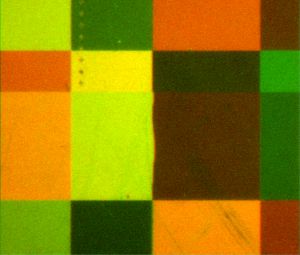The use of biological extracts from cell membranes for the preparation of surfaces of new materials opens a window for understanding the basic interrelationships between cells.

Two articles recently published by biophysicists from the University of Oregon suggest that placing fats (lipids) and other chemical components from the cell membrane on surfaces may lead to a completely new family of materials obtained through self-assembly, materials that could be used in precision optics components, nanotechnology, electronics and various pharmaceutical preparations.
Although the findings are only basic and preliminary, they provide new research directions regarding the understanding of nature at its nanoscale, a field in which the directionality of tiny proteins is crucial, said Raghuveer Parthasarathy, a researcher at the Institute of Molecular Biology at the University of Oregon.
In the May issue of the scientific journal Soft Matter, the research team describes how they placed biological material - a thin layer of lipids from cell membranes - on tiny glass spheres with a diameter of one millionth of a meter, in order to examine colloidal interactions.
Colloids (Wikipedia entry) are tiny particles dispersed in liquids: milk, paints, many food products, cosmetics and pharmaceuticals. Compared to atoms and particles, colloidal materials are large and the preparation of synthetic colloids with desirable properties is an important goal in a variety of technological fields such as optics and nanotechnology.
Before placing the biological membrane on them, the spheres, which are all negatively charged, repel each other. When the membrane is attached to the ball, the conditions change sharply. Suddenly, the coated spheres are attracted to each other.
"The finding was unusual," notes the lead researcher. "Quite-charged particles should not attract each other. Admittedly, scientists have observed such attractions in other colloidal systems over the past decade, but no one has yet understood it. Now, we have the first system in which attraction between colloidal particles can be controlled simply by adding ferrodes derived from biological cell membranes. We are able to adjust the attraction or repulsion to the entire field simply by changing the membrane composition. This finding is important both for technological applications and for studying the basic mechanisms of colloidal interactions."
The findings were obtained with the use of an inverted microscopy method in which the glass spheres are placed inside a 655 nanometer laser beam originating from a diode - a method specially developed in this laboratory.
The findings imply, the researcher explains, that specially adapted biological membranes, those that are combined with new synthetic materials, may be used as special control "handles" that can precisely direct the activity of different materials.
In another article published online in the scientific journal Journal of the American Chemical Society (JACS) at the beginning of July of this year, the same researchers collaborated with organic chemists from the University of Berkeley in California in order to understand how different molecules are oriented and act on cell membranes, those molecules responsible for the interactions between the cells.
The joint research team prepared artificial furrows, which mimic the proteins of the cell membrane and resemble a sort of brush bristles, which contain radiating detectors at their outer end. These tiny polymers were connected to artificial membranes that were placed on top of a piece of tin that functions as a mirror, and enables precise optical measurements of the separate directions.
Electron microscopy identified the presence of a stiff, brush bristle-like sugar protein, similar in structure to natural cell surface proteins. Interactions between the cells occur when these bristles stick out from the surface of the membranes - a feature whose control is still very limitedly understood.
The surprising finding was, the researcher explains, that the bristles containing the sugar stood out like the trees in the forest only for certain radioactive detectors, which made up only about two percent of the total weight of the foal.
The most important conclusion from this finding was that even the smallest change in the surface of the isolated surface affects its directionality, notes the lead researcher.
The goal, the lead researcher points out, is to find a way to control this bristle directionality by chemical or optical means in order, ultimately, to control the interrelationships between the cells. This control in the preparation of artificial materials could, he adds, have potentially very important applications in the electronics industry.
The aforementioned research group is now examining DNA samples. anchored to cell membranes in order to compare the findings and check if it is possible to obtain switching options (on-off) of the separate directions.
"There are brush bristle-like proteins on the surface of the cell that are extremely important for cellular interactions in the immune system," explains the researcher. "On the surface of each and every cell there is a "forest" of special protein profiles that activate intercellular interactions. For their efficient activity, these proteins need to stick to the surface itself. What is the exact mechanism that allows them to stick up or lean down? We don't have any solid and actual information about that yet. Knowing the genome and the nature of the proteins are indeed important, but this information in itself does not provide you with answers to this important question."

One response
It's just amazing that you discovered something that will help you a lot